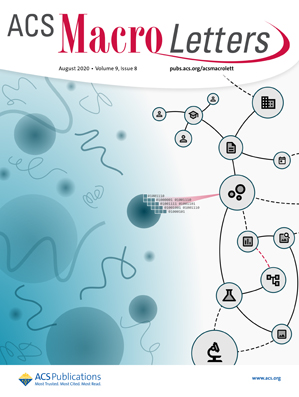Nanoparticle Percolation Improves the Mechanical Properties of Polymer Nanocomposite Films.
IF 5.1
Q1 POLYMER SCIENCE
引用次数: 0
Abstract
Nanoparticle (NP) percolation governs the mechanical reinforcement of polymer nanocomposite (PNC) films. In this study, we demonstrate that both internal network morphology and near-surface morphology of NPs influence the mechanical properties of PNC films composed of poly(methyl methacrylate)-grafted silica nanoparticles (PMMA-NPs) in a poly(styrene-ran-acrylonitrile) (SAN) matrix. By systematically varying film thickness and annealing conditions, we achieve distinct NP morphologies, including continuous pillars, discrete pillars, clusters, and interconnected networks, each exhibiting different levels of NP percolation. Atomic force microscopy nanoindentation reveals that films with interconnected networks exhibit the highest reduced modulus (7.6 GPa), nearly quadrupling that of as-cast films with uniform NP dispersion (1.8 GPa), along with a substantial increase in hardness (624 MPa compared to 298 MPa). Notably, surface NP structures formed during annealing contribute to an enhanced modulus at low loads. These findings establish a direct structure-property relationship, providing insights into designing mechanically robust PNCs for applications in coatings, electronics, and energy storage.纳米颗粒的渗透改善了聚合物纳米复合膜的力学性能。
纳米粒子(NP)的渗透决定了聚合物纳米复合材料(PNC)薄膜的机械增强。在这项研究中,我们证明了NPs的内部网络形态和近表面形态都会影响聚(甲基丙烯酸甲酯)接枝二氧化硅纳米颗粒(PMMA-NPs)在聚(苯乙烯-丙烯腈)(SAN)基体上组成的PNC薄膜的力学性能。通过系统地改变薄膜厚度和退火条件,我们实现了不同的NP形态,包括连续柱、离散柱、簇和相互连接的网络,每种形态都表现出不同程度的NP渗透。原子力显微镜纳米压痕显示,具有相互连接网络的薄膜表现出最高的还原模量(7.6 GPa),几乎是均匀NP分散的铸态薄膜(1.8 GPa)的四倍,同时硬度大幅增加(624 MPa比298 MPa)。值得注意的是,在退火过程中形成的表面NP结构有助于在低负载下增强模量。这些发现建立了直接的结构-性能关系,为设计用于涂料、电子和储能的机械坚固的pnc提供了见解。
本文章由计算机程序翻译,如有差异,请以英文原文为准。
求助全文
约1分钟内获得全文
求助全文
来源期刊
CiteScore
10.40
自引率
3.40%
发文量
209
审稿时长
1 months
期刊介绍:
ACS Macro Letters publishes research in all areas of contemporary soft matter science in which macromolecules play a key role, including nanotechnology, self-assembly, supramolecular chemistry, biomaterials, energy generation and storage, and renewable/sustainable materials. Submissions to ACS Macro Letters should justify clearly the rapid disclosure of the key elements of the study. The scope of the journal includes high-impact research of broad interest in all areas of polymer science and engineering, including cross-disciplinary research that interfaces with polymer science.
With the launch of ACS Macro Letters, all Communications that were formerly published in Macromolecules and Biomacromolecules will be published as Letters in ACS Macro Letters.

 求助内容:
求助内容: 应助结果提醒方式:
应助结果提醒方式:


